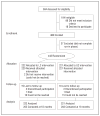Chronic disease management for tobacco dependence: a randomized, controlled trial
- PMID: 22123795
- PMCID: PMC4110895
- DOI: 10.1001/archinternmed.2011.500
Chronic disease management for tobacco dependence: a randomized, controlled trial
Abstract
Background: Tobacco dependence disorder is a chronic relapsing condition, yet treatment is delivered in discrete episodes of care that yield disappointing long-term quit rates.
Methods: We conducted a randomized controlled trial from June 1, 2004, through May 31, 2009, to compare telephone-based chronic disease management (1 year; longitudinal care [LC]) with evidence-based treatment (8 weeks; usual care [UC]) for tobacco dependence. A total of 443 smokers each received 5 telephone counseling calls and nicotine replacement therapy by mail for 4 weeks. They were then randomized to UC (2 additional calls) or LC (continued counseling and nicotine replacement therapy for an additional 48 weeks). Longitudinal care targeted repeat quit attempts and interim smoking reduction for relapsers. The primary outcome was 6 months of prolonged abstinence measured at 18 months of follow-up.
Results: At 18 months, 30.2% of LC participants reported 6 months of abstinence from smoking, compared with 23.5% in UC (unadjusted, P = .13). Multivariate analysis showed that LC (adjusted odds ratio, 1.74; 95% CI, 1.08-2.80), quit attempts in past year (1.75; 1.06-2.89), baseline cigarettes per day (0.95; 0.92-0.99), and smoking in the 14- to 21-day interval post-quit (0.23; 0.14-0.38) predicted prolonged abstinence at 18 months. The LC participants who did not quit reduced smoking more than UC participants (significant only at 12 months). The LC participants received more counseling calls than UC participants (mean, 16.5 vs 5.8 calls; P < .001), longer total duration of counseling (283 vs 117 minutes; P < .001), and more nicotine replacement therapy (4.7 vs 2.4 boxes of patches; P < .001).
Conclusion: A chronic disease management approach increases both short- and long-term abstinence from smoking.
Trial registration: clinicaltrials.gov Identifier: NCT00309296.
Figures




References
-
- US Department of Health and Human Services (USDHHS), Centers for Disease Control and Prevention, National Center for Chronic Disease Prevention and Health Promotion, Office on Smoking and Health. . The Health Consequences of Smoking: A Report of the Surgeon General. Washington, DC: USDHHS; 2004.
-
- PHS Guideline Update Panel, Liaisons, and Staff. [Accessed August 23, 2011];Treating tobacco use and dependence: 2008 update. 2008 http://www.rcjournal.com/contents/09.08/09.08.1217.pdf.
-
- McLellan AT, Lewis DC, O’Brien CP, Kleber HD. Drug dependence, a chronic medical illness: implications for treatment, insurance, and outcomes evaluation. JAMA. 2000;284(13):1689–1695. - PubMed
-
- Fiore MC, Bailey WC, Cohen SJ, et al. Treating Tobacco Use and Dependence: Clinical Practice Guideline. Rockville, MD: US Dept of Health and Human Services, Public Health Service; 2000.
-
- Polisena J, Coyle D, Coyle K, McGill S. Home telehealth for chronic disease management: a systematic review and an analysis of economic evaluations. Int J Technol Assess Health Care. 2009;25(3):339–349. - PubMed
Publication types
MeSH terms
Associated data
Grants and funding
LinkOut - more resources
Full Text Sources
Medical
Miscellaneous

